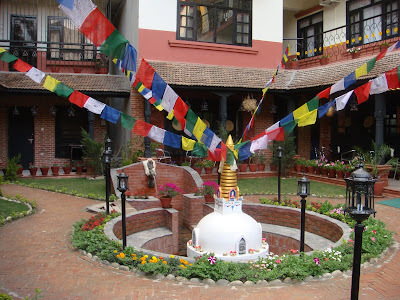16th April 2011. Kathmandu.
I had to make a phone call.
Because everyone else was doing so. Calling up family to let them know they were safe.
Unfortunately for me, I come across as a strong independent woman and everybody assumes I am safe and can take care of myself. No one really worries about me. But I called anyway. Mom had asked me to.
I went to the phone booth after dinner to make the call.
Different people had been charged different rates per minute of call. 20, 30, 50 Nepali rupees.
I and friend walked up and down the narrow road looking for a booth and most of them were closed.
We found one. I made my call.
The charge came to 20 Nepali rupees. I paid 20 Indian rupees. After a quick math, we agreed that the boy owed me 10 Nepali rupees.
He held the 10 Nepali rupee note in his right hand, while his left hand touched the right elbow.
I was touched. It was ‘the smell of that house I had once lived in’.
(I am borrowing words from a friend here)
I asked him if that’s how he gave, whenever he gave something to people. Yes, he said.
‘Do you know why it is done like that?’ I asked
'Aadar', he said - meaning respect.
We at home too had been trained to give like that. Always give with your right hand. And the left hand should be touching the right elbow. Or the right wrist. Or join both hands in a cup.
You should give with both hands - it symbolizes whole hearted giving.
Whether you give alms to a beggar, change to a rickshaw driver, money to a shopkeeper, water to a thirsty…
I was touched to find people here practicing and keeping alive a tradition, a nuance that we at home had discarded long ago. The youth of today would even scoff at it.
It was gone. Almost. Only during religious or cultural events, when people performed certain rituals and rites, they use both their hands. When making an offering to God, when pouring ghee and other offering into the holy fire…
Symbolism. What’s a culture with it?
When we find symbolism in literature we appreciate it. Why, when we find symbolism in other cultures we become curious and even reverent.
Our own life and our social traditions in India are full of such symbolism and nuance but we scoff at them.
Superstition, blind belief and other such names we call it.
We fail miserably to understand that it’s the spirit and nuance behind the symbolism that is the whole point.
In the days that followed, I would be touched by a few people – naïve and otherwise, in high and low places alike, extending their right hand to me with their left one gently touching the right elbow. Not really the Buddhists in the mountains where we spent most of our time, but the Hindus in Kathmandu and elsewhere.
But the very first time I observed the gesture, it lingered in my mind. It was ‘the smell of that home I have once lived in’. In a tiny shop, on a narrow street of an unknown land full of strange looking people, I had met the last shadow of a dying innocence that had been swept out of my big home.
A few weeks later, in my city, sitting in a shop selling plastics, I would think of this Nepali boy and his innocent gesture, as the busy owner of the plastic shop, whom I had asked to show me a stool I was interested in buying, would push it callously towards me with his left leg.
As I returned from the phone booth and reached the main road, a few young boys with spiky hair accosted us with the shouts of 'Nepali dance...Nepali dance dekhna hai?’
I thought they were going to perform on the street - just like our Nukkad Natak...
I turned to the boy to ask something when my friend hushed me and said, ‘they are here to take people to dance bars. Lets go quickly’. He pointed to the topmost floor of a building to our right.
I looked up and saw the flickering disco lights. The pink and yellow lights coloured the walls in turn. Apparently the music was on, liquor too, and women were dancing. I smiled.
I thought about the innocent boy in the phone booth.
And wondered if he would go to the dance bar that night after closing his shop.








































































